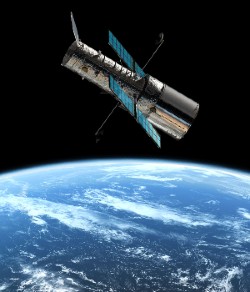Religion and Rockets
By Neil Earle
 Yuri Gagarin
Yuri GagarinThe New York Times for April 12, 1961 – sixty years ago – was suitably ecstatic.
“SOVIET ORBITS MAN AND RECOVERS HIM; SENT MESSAGES WHILE CIRCLING EARTH”
Most of us in my generation remember that event quite well. While NASA rockets at cape Canaveral were blowing up on their pads here, the Soviet Union had sent Russian Army Major Yuri Gagarin in 5-ton spacecraft 187 miles above the earth. This proved to be the second humiliating blow the United States received following the Soviet Sputnik device in October 1957 which set off a well-publicized space race between the two nations.
The historians record that story well. What is sometimes forgotten, and which the Christian essayist C.S. Lewis of Cambridge did not overlook, was the claim made by Russia’s second cosmonaut, Gherman Titov – “I didn’t see God up there.”
This remark accentuated the tone of the anti-God anti-traditional 1960s that were to unfold. Lewis was one of the best defenders of the faith we had in the mid-20th Century and in a writing I cannot now find, closely akin to this titled “Religion and Rocketry” he showed he was not about to shrink away from the challenges that the 1950s and 1960s techno-craze seemed to be offering the Christian church or belief in general.
“One Who Inhabits Eternity”
Lewis would agree that any man who could think he had eradicated the concept of God by travelling 187 miles “up there” could not possibly be referring to the God of the Bible. After all, One who claims to inhabit Eternity (Isaiah 57:15) spoke to a friend of his named Isaiah in a book this Personage inspired wherein he laid claim to much more than even our own solar system.
 Susan and Neil Earle at C.S. Lewis event in 2017 while he served as Interim Director of local Lewis group.
Susan and Neil Earle at C.S. Lewis event in 2017 while he served as Interim Director of local Lewis group.“Lift up your eyes on high,” the Creator says of the night sky, “who created these? He who brings out their host by number, calling them all by name, by the greatness of his might and because he is strong in power not one is missing” (Isaiah 40:36).
Apparently, we can see 5000 stars by the naked eye so Isaiah’s God must have had more than that in mind. Oh, yes. By a neat coincidence just as April 12 recalled Gagarin’s feat, April 24 hosts the 31st anniversary of the Hubble Space Telescope launched in 1990. This magnificent orbiting scope has greatly expanded our knowledge of the night sky and our sand-speck of a home in space. By shooting its lens on to a hitherto “empty” part of the night sky, the Hubble shows 100s of millions of “new” stars and galaxies even the astronauts had not known about.
Given all this we may consider Gagarin’s boast of not seeing God slightly comparable, on an imaginative level, of one ant traveling to another ant hill and saying, “I didn’t see any human beings. That shows they don’t exist.”
There is no doubt, this cosmos we all inhabit is a lot bigger than anyone – even Yuri Gagarin – could have imagined in 1961. There is also the further point that the God of the Bible has been described by his interpreters the theologians as utterly transcendent, beyond anything we can conceive and beyond these bounds of Time and Space we are confined to at this stage in human development.
 Hubble space telescope
Hubble space telescopeStars and Sparrows
God is spirit and yet a being who keeps track of every sparrow that falls. He is not made of flesh and blood and physical matter yet has brought all of this into existence, seemingly by the power of his will alone. Human thinkers have always been aware of this from Heraclitus of Ephesus who postulated the identity of One Overall Master Intelligence guiding all we see about us (the Logos) to a host of Christian theologians ranging from the author of Psalm 19 (The earth shows forth his handiwork) to men of the Middle Ages down to priest-quantum physicists today such as John Polkinghorne.
It is not slighting Yuri Gagarin’s achievement to say, Shoot an atheist into space and he will glimpse a rotating planet; send a Christian and he will exclaim that some great Mind has had to have been behind it all, precisely how many American astronauts reacted to the embarrassment of the “tecchies” at NASA. Or, phrased another way, send an atheist into the Wilderness and they will find sand; send a Christian and they will – likely as not – find God. Even in a burning bush.
So as we crawl from our anthill to the next, figuratively speaking, let us not lose our sense of perspective. God cannot be found though radar telescopes and Elon Musk’s rockets. But as the overwhelming testimony of scientists from the Greeks to the local Sunday School teacher still advise: “Beware! Your God may be too small. He is there and He has not remained mute to those who seek him.”